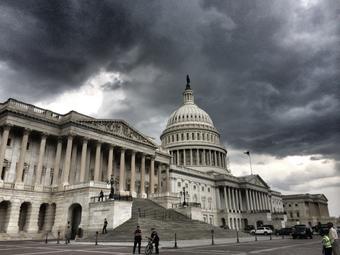Last week I attended the Section 230 cage match workshop at the DOJ. It was a packed house, likely because AG Bill Barr gave opening remarks. It was fortuitous timing for me: my article with Jennifer Huddleston, The Erosion of Publisher Liability in American Law, Section 230, and the Future of Online Curation, was published 24 hours before the workshop by the Oklahoma Law Review.
These were my impressions of the event:
I thought it was pretty well balanced event and surprisingly civil for such a contentious topic. There were strong Section 230 defenders and strong Section 230 critics, and several who fell in between. There were a couple cheers after a few pointed statements from panelists, but the audience didn’t seem to fall on one side or the other. I’ll add that my friend and co-blogger Neil Chilson gave an impressive presentation about how Section 230 helped make the “long tail” of beneficial Internet-based communities possible.
AG Bob Barr gave the opening remarks, which are available online. A few things jumped out. He suggested that Section 230 had its place but Internet companies are not an infant industry anymore. In his view, the courts have expanded Section 230 beyond drafters’ intent, and the Reno decision “unbalanced” the protections, which were intended to protect minors. The gist of his statement was that the law needs to be “recalibrated.”
Each of these points were disputed by one or more panelists, but the message to the Internet industry was clear: the USDOJ is scrutinizing industry concentration and its relationship to illegal and antisocial online content.
The workshop signals that there is now a large, bipartisan coalition that would like to see Section 230 “recalibrated.” The problem for this coalition is that they don’t agree on what types of content providers should be liable for and they are often at cross-purposes. The problematic content ranges from sex trafficking, to stalkers, to opiate trafficking, to revenge porn, to unfair political ads. For conservatives, social media companies take down too much content, intentionally helping progressives. For progressives, social media companies leave up too much content, unwittingly helping conservatives.
I’ve yet to hear a convincing way to modify Section 230 that (a) satisfies this shaky coalition, (b) would be practical to comply with, and (c) would be constitutional.
Now, Section 230 critics are right: the law blurs the line between publisher and conduit. But this is not unique to Internet companies. The fact is, courts (and federal agencies) blurred the publisher-conduit dichotomy for fifty years for mass media distributors and common carriers as technology and social norms changed. Some cases that illustrate the phenomenon:
In Auvil v. CBS 60 Minutes, a 1991 federal district court decision, some Washington apple growers sued some local CBS affiliates for airing allegedly defamatory programming. The federal district court dismissed the case on the grounds that the affiliates are conduits of CBS programming. Critically, the court recognized that the CBS affiliates “had the power to” exercise editorial control over the broadcast and “in fact occasionally [did] censor programming . . . for one reason or another.” Still, case dismissed. The principle has been cited by other courts. Publishers can be conduits.
Conduits can also be publishers. In 1989, Congress passed a law requiring phone providers to restrict “dial-a-porn” services to minors. Dial-a-porn companies sued. In Information Providers Coalition v. FCC, the 9th Circuit Court of Appeals held that regulated common carriers are “free under the Constitution to terminate service” to providers of indecent content. The Court relied on its decision a few years earlier in Carlin Communications noting that when a common carrier phone company is connecting thousands of subscribers simultaneously to the same content, the “phone company resembles less a common carrier than it does a small radio station.”
Many Section 230 reformers believe Section 230 mangled the common law would like to see the restoration of the publisher-conduit dichotomy. As our research shows, that dichotomy had already been blurred for decades. Until advocates and lawmakers acknowledge these legal trends and plan accordingly, the reformers risk throwing out the baby with the bathwater.
Relevant research:
Brent Skorup & Jennifer Huddleston, The Erosion of Publisher Liability in American Law, Section 230, and the Future of Online Curation (Oklahoma Law Review).
Brent Skorup & Joe Kane, The FCC and Quasi–Common Carriage: A Case Study of Agency Survival (Minnesota Journal of Law, Science & Technology).


 Congress has become a less important player in the field of technology policy. Why did that happen, and what are the ramifications for technological governance efforts going forward?
Congress has become a less important player in the field of technology policy. Why did that happen, and what are the ramifications for technological governance efforts going forward? The Technology Liberation Front is the tech policy blog dedicated to keeping politicians' hands off the 'net and everything else related to technology.
The Technology Liberation Front is the tech policy blog dedicated to keeping politicians' hands off the 'net and everything else related to technology.